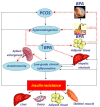Endocrine Aspects of Environmental "Obesogen" Pollutants
- PMID: 27483295
- PMCID: PMC4997451
- DOI: 10.3390/ijerph13080765
Endocrine Aspects of Environmental "Obesogen" Pollutants
Abstract
Growing evidence suggests the causal link between the endocrine-disrupting chemicals (EDCs) and the global obesity epidemics, in the context in the so-called "obesogenic environment". Dietary intake of contaminated foods and water, especially in association with unhealthy eating pattern, and inhalation of airborne pollutants represent the major sources of human exposure to EDCs. This is of particular concern in view of the potential impact of obesity on chronic non-transmissible diseases, such as type 2 diabetes, cardiovascular disease, and hormone-sensitive cancers. The key concept is the identification of adipose tissue not only as a preferential site of storage of EDCs, but also as an endocrine organ and, as such, susceptible to endocrine disruption. The timing of exposure to EDCs is critical to the outcome of that exposure, with early lifetime exposures (e.g., fetal or early postnatal) particularly detrimental because of their permanent effects on obesity later in life. Despite that the mechanisms operating in EDCs effects might vary enormously, this minireview is aimed to provide a general overview on the possible association between the pandemics of obesity and EDCs, briefly describing the endocrine mechanisms linking EDCs exposure and latent onset of obesity.
Keywords: endocrine-disrupting chemicals; inflammation; obesity; obesogenic environment.
Figures


References
-
- Ollikainen M., Ismail K., Gervin K., Kyllönen A., Hakkarainen A., Lundbom J., Järvinen E.A., Harris J.R., Lundbom N., Rissanen A., et al. Genome-wide blood DNA methylation alterations at regulatory elements and heterochromatic regions in monozygotic twins discordant for obesity and liver fat. Clin. Epigenet. 2015;7:39. doi: 10.1186/s13148-015-0073-5. - DOI - PMC - PubMed
Publication types
MeSH terms
Substances
LinkOut - more resources
Full Text Sources
Other Literature Sources
Medical

